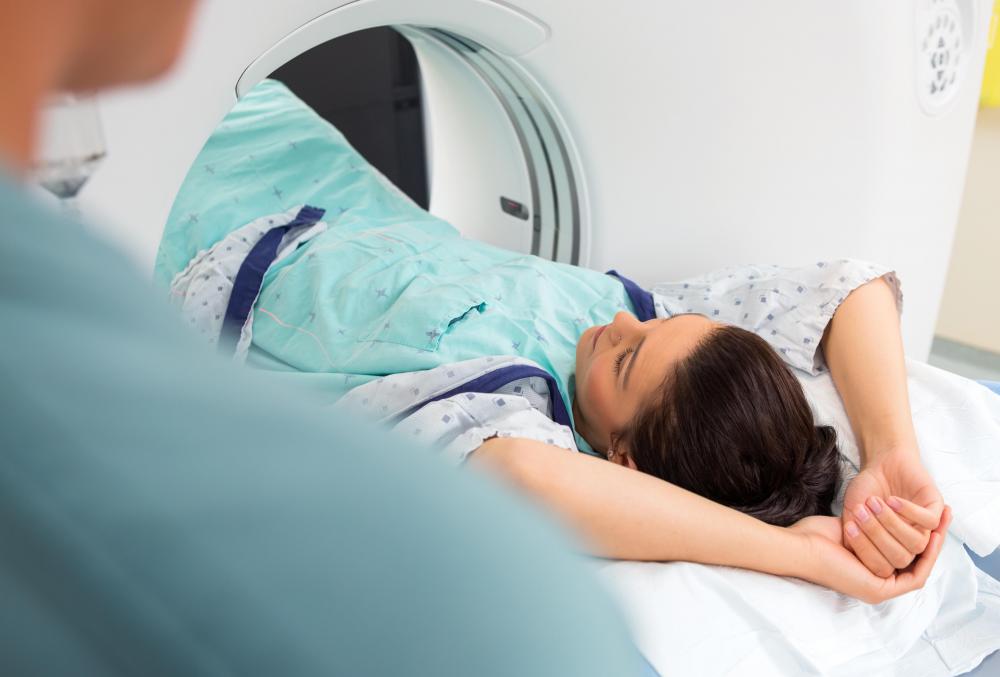At TheHealthBoard, we're committed to delivering accurate, trustworthy information. Our expert-authored content is rigorously fact-checked and sourced from credible authorities. Discover how we uphold the highest standards in providing you with reliable knowledge.
What is an Ovarian Neoplasm?
An ovarian neoplasm is a collection of abnormal cells or tissues originating within the ovary. Also known as an ovarian tumor, this type of growth may result in the formation of a benign cyst or malignant tumor. Extensive examination and testing is necessary to determine the composition of an ovarian neoplasm. If ovarian cancer is confirmed, treatment may involve surgery and the administration of chemo and radiation therapies.
There is no known cause for the abnormal cell development associated with neoplasm formation. It has been asserted that an impairment of the tissue-renewal process that occurs following menstruation may contribute to such abnormal cell development. Increased hormone levels associated with menstruation may also play a part in the stimulation of abnormal cell growth.

The type of ovarian neoplasm that forms is dependent on the category of cells involved in its development. Stromal neoplasms develop in the hormone-producing tissue that supports the ovary. Epithelial tumors are those that form within the cells of the outermost layer of the ovaries, or surface tissue. Germ cell neoplasms form in the portion of the ovary that produces eggs.

A benign ovarian neoplasm is generally comprised of abnormal cells that do not spread to surrounding tissues or organs. Benign neoplasms are generally left untreated and may dissolve independently over time. Neoplasms that are determined to be malignant possess the ability to spread to other parts of the body, or metastasize, by affecting immediate tissues and cells, the bloodstream, or lymphatic system.

Women with a malignant ovarian tumor may experience a variety of symptoms that may mimic those of other conditions. Ovarian cancer does not possess any specific tell-tale symptoms that are easily identified. Symptoms of ovarian cancer generally remain persistent and worsen gradually with time.
Those with a malignant ovarian neoplasm may develop pelvic discomfort, abdominal swelling and tenderness, and persistent, abrupt urges to urinate. Some women may experience sudden, unexplained constipation, chronic nausea or indigestion, or changes in their menstrual cycle. Additional signs may include a loss of appetite, lethargy, and lower back pain.

Since there is no standard testing procedure to determine the presence of ovarian cancer, a variety of screening and preliminary tests may be conducted. Women may undergo a pelvic examination and ultrasound to evaluate the condition of the ovaries and check for any abnormalities. Signs of ovarian cancer may be further evaluated through the administration of a CA 125 blood test, which evaluates CA 125 levels in the bloodstream. Elevated levels of this naturally occurring protein may be indicative of the presence of a malignant neoplasm, or ovarian cancer. Additional testing may involve the use of imaging testing, such as magnetic resonance imaging (MRI) and a computerized tomography (CT) scan, to obtain more detailed images of the affected ovary.

Once malignancy is suspected, a surgical procedure known as a laparotomy may be performed to confirm the composition of the neoplasm. The procedure requires an incision in the abdomen to access the abdominal cavity and obtain a biopsy of the abdominal fluid and affected ovary. For some women, a less invasive procedure known as a laparoscopy may be employed, which involves the introduction of two small incisions and the use of equally small tools to conduct the biopsy. If a diagnosis of ovarian cancer is confirmed, the type of neoplasm will be determined and a removal of the affected tissue performed.

Upon its discovery, a staging of ovarian cancer is generally conducted on a scale ranging from one to four. Those given a staging of one have not spread beyond the ovary and are in an early stage of development. Stages two and three are given to those cancers that have spread to other locations within the pelvic or the abdominal areas, including the lymph nodes. Ovarian cancers determined to be stage four are in the most advanced developmental stage and have spread beyond the abdominal area.

The initial treatment for a malignant ovarian neoplasm generally involves the removal of the neoplasm, as well as the fallopian tubes, both ovaries, and the uterus. Surrounding tissues and lymph nodes may also be removed and sent for laboratory analysis. Following surgery, chemo and radiation therapies may be utilized to further eradicate any remaining cancerous cells.

Chemotherapy involves the oral or intravenous administration of anti-cancer drugs designed to target and eradicate cancerous cells. Individuals who undergo chemotherapy may experience side effects that include nausea, fatigue, and weight loss. Radiation therapy is usually utilized in the treatment of advanced ovarian cancers and involves the use of highly concentrated energy beams focused specifically on the affected area that work to eliminate cancerous cells. Side effects associated with radiation therapy include fatigue and redness or irritation at the site of administration.
AS FEATURED ON:
AS FEATURED ON:


















Discussion Comments
If you have symptoms that seem to suggest an ovarian neoplasm, don't panic until you see a doctor for an accurate diagnosis. There are many issues that aren't serious that can cause similar pain. If an ovarian neoplasm is diagnosed however, it is necessary to have it checked out to rule out serious problems such as a malignancy.
Post your comments